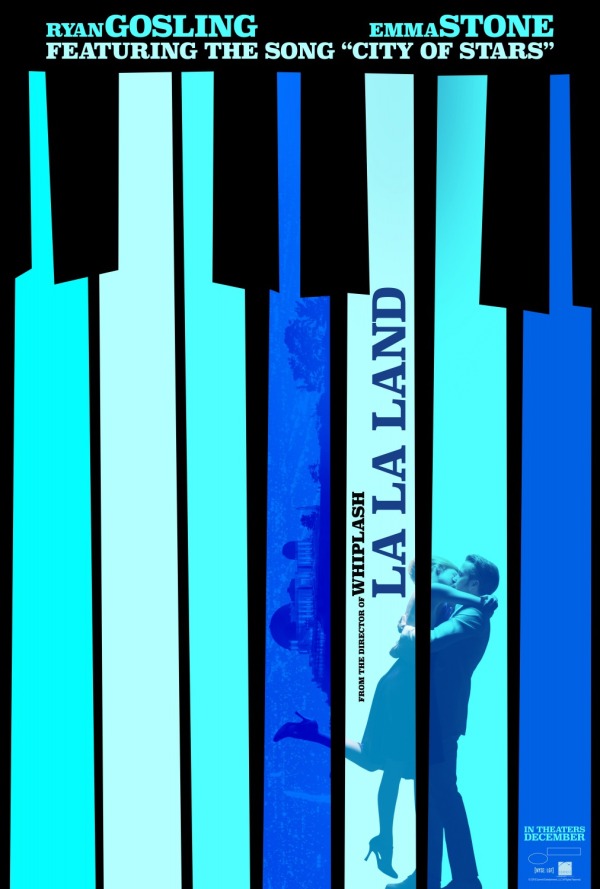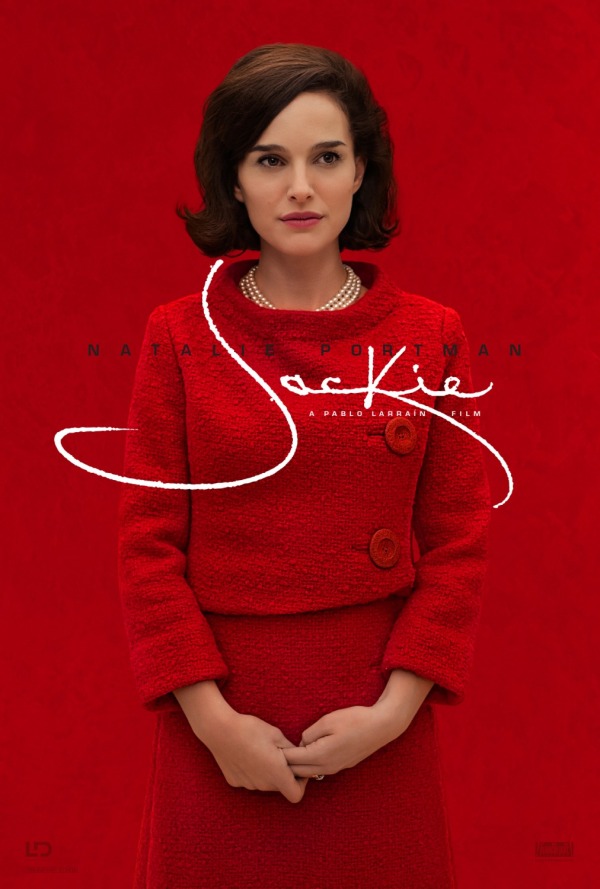LA LA LAND (2016, directed by Damien Chazelle, 128 minutes, U.S.)
JACKIE (2016, directed by Pablo Larain, 99 minutes, U.S.)
![]() BY DAN BUSKIRK FILM CRITIC Trepidation preceded me sitting down for director Damien Chazelle’s follow-up to the award-winning hit Whiplash, a film that admittedly irked me in a most personal way. For those lucky enough to have missed it, Whiplash was a musical drama proposing that the best way to craft a new generation of jazz geniuses was to abuse them like a crazed drill sergeant in a house-of-horrors-come-classroom where never is heard an encouraging word. Driven by a riveting performance by J.K. Simmons, counting off the beat like a J. Jonah Jameson from Hell, the film’s musical aesthetic seemed frozen in that late ’60s Buddy Rich Big Band sound as well as never acknowledging that the teaching method the film was prescribing was miles away from the formative experiences that gave birth to the jazz giants that the film supposedly championed. Personally, as someone who has spent the last decade and a half chronicling jazz as a living modern music as host of a weekly jazz radio show, it was profoundly disheartening to see one of the music’s biggest cinematic showcases preaching the false fable that jazz died 40-odd years ago with The Duke and Satchmo (trust me, it didn’t).
BY DAN BUSKIRK FILM CRITIC Trepidation preceded me sitting down for director Damien Chazelle’s follow-up to the award-winning hit Whiplash, a film that admittedly irked me in a most personal way. For those lucky enough to have missed it, Whiplash was a musical drama proposing that the best way to craft a new generation of jazz geniuses was to abuse them like a crazed drill sergeant in a house-of-horrors-come-classroom where never is heard an encouraging word. Driven by a riveting performance by J.K. Simmons, counting off the beat like a J. Jonah Jameson from Hell, the film’s musical aesthetic seemed frozen in that late ’60s Buddy Rich Big Band sound as well as never acknowledging that the teaching method the film was prescribing was miles away from the formative experiences that gave birth to the jazz giants that the film supposedly championed. Personally, as someone who has spent the last decade and a half chronicling jazz as a living modern music as host of a weekly jazz radio show, it was profoundly disheartening to see one of the music’s biggest cinematic showcases preaching the false fable that jazz died 40-odd years ago with The Duke and Satchmo (trust me, it didn’t).
Jazz again figures prominently in Chazelle’s latest and while the director’s musical aesthetic seems as freeze-dried in the past as ever, he’s really working a cinema lover’s soft spot by resurrecting the full-blown Hollywood musical stylish exemplified by those Technicolor MGM musicals of yore. Following a struggling jazz pianist (the always amiable Ryan Gosling) and a down on her luck actress (skinny “It” girl Emma Stone) as their careers and romance rise and fall, La La Land handily conquered my antipathy and post-election heeby-jeebies by the sheer force of its exuberant style. But the film is also more than an elaborate exercise in nostalgia, it’s the cracks in Chazelle’s revivalist instincts that give the film its charged valence.
By now the opening number, shot on a Los Angeles freeway ramp, has been front and center in the film’s promotion. Let’s hope at least some viewers enjoyed that revelatory moment as we watch the number of dancers jumping out of their cars double, and double again. Especially with the expanse of a theater screen, the serviceable tunes by Justin Hurwitz and the star-quality of Stone and Gosling (in their third on-screen pairing) takes wing with the elaborately staged numbers and the glory of non-computer generated spectacle.
The story is as wispy as a typical ’30 dancing and singing extravaganza. Gosling’s Sebastian is a pianist who is sticking to his nostalgic purist ideas about jazz (hung up around the 1950s) while harboring dreams of opening his own nightclub. Sebastian is so adorable that Mia, a barista/actress still looking for a break, wades through his many tirades about “real jazz” to show herself worthy of his heart.
But Sebastian’s dreamland seems pretty sterile, a perspective I’m not sure Chazelle really shares. The scenes of Gosling selling out have more spark, whether he’s in ’80s gear doing Flock of Seagulls covers at a party gig or adding little jazzy flourishes to the easy-going-down soul of John Legend (quite natural playing Keith, Sebastian’s successful old music school buddy). I was surprised when Keith finally asks Sebastian the question that has been bugging me about Chazelle’s jazz obsession all along: basically, how are you honoring the spirit of revolutionary musicians by rigorously copying their styles and techniques?
Because in a world Chazelle never acknowledges, improvisational jazz music continues, music that has absorbed the advances of the Coltrane, Monk and Miles (Chazelle’s references don’t go much deeper) and used it as a launching pad for a number of fresh paths. Recreating Monk’s arrangements or playing smooth soul aren’t the only two paths for a serious jazz-schooled talent but it is sad to see that for a second film in a row, Chazelle is selling a very consecrative perspective of the possibilities of jazz.
Gosling and Stone have both been stars long enough to draw their own bitchy detractors but for me the climactic show piece, a beautifully-staged evocation of the sentiment and power a song and performance can hold, was enough to beat down the lingering gripes I have, all complaints that come from loving the genres and forms being plundered perhaps a bit too much. Surprisingly, it has gone unmentioned that the musical La La Land might most resemble is Scorsese delirious 1977 flop, New York, New York. Timing seems to be on this film’s side though, La La Land smells like a hit and that’s something about which, for once, I’ve got no complaint.
If there’s any take away I’ve had about politics over the years, it is a wariness of how the political elite uses their personal stories to sell their politics. You see this in the sense that people voted for Donald Trump the personality more than for his pro-oligarch policies but you see it also in how Obama and Hillary Clinton let their identities as an African American and a woman give the impression that their agendas were more liberal than they really were. Hillary Clinton’s lack of success with younger voters also made me think that if one doesn’t live through the era when a political figure’s persona is being crafted and sold, the emotional attachment may not be as strong either.
This idea further implanted itself while watching Jackie at a press screening where many of the critics were in their 60s. In the theater, you could feel how moved the story of the mourning First Lady was for them. At the risk of revealing myself as cold-hearted or worse, unpatriotic, I couldn’t seem to get into the swing of the film’s near-religious fixation Jackie or the JFK assassination’s bloody details.
Looking like an extended early Mad Men episode, Jackie’s post-assassination days are presented in fragmented form while being interviewed by a reporter for Life (played by Billy Crudup, in a badly-written part). We see her entertaining at the White House before the tragedy, and giving her famous televised tour but we also see her in post-shooting shock, washing the blood from her dress and body. Along the way she is presented as coming into her own after the shooting, transforming herself from a somewhat shallow society girl made good into a force powerful enough to buck the big boys and carry out her late husband’s funeral in a way that she thought fitting.
Talking to Philly movie critic on the prowl Nathan Lerner, I could see where all this would take on a bigger-than-life glow if you lived through the events as a teen. By contrast, watching Portman’s Jackie drunk and dancing around the White House quarters in each of her fancy dresses one last time couldn’t bring me to mourn the loss of her royal post, the Princess fantasy never seeming like a healthy or just role model. Without this admiration, the film seemed about a cinematic as watching any American family make funeral preparations, by which I mean, not very. With all this tasteful myth-making I was a bit surprised that the film was building up to a recreation of the assassination from Jackie’s perspective but respectful or not, the film isn’t about to underestimate the audience’s desire for violence. Jackie is ultimately a Passion Play for those still enamored with the myth of the Kennedys brief reign as King and Queen of Camelot, the rest of us might want to keep a respectful distance from the ceremony.


